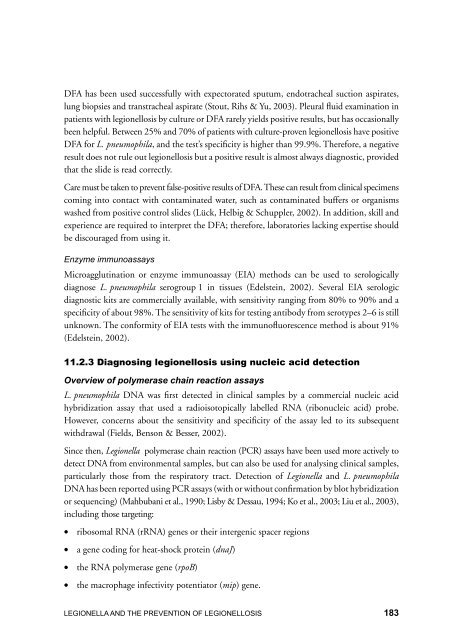LEGIONELLA - World Health Organization
LEGIONELLA - World Health Organization
LEGIONELLA - World Health Organization
You also want an ePaper? Increase the reach of your titles
YUMPU automatically turns print PDFs into web optimized ePapers that Google loves.
DFA has been used successfully with expectorated sputum, endotracheal suction aspirates,<br />
lung biopsies and transtracheal aspirate (Stout, Rihs & Yu, 2003). Pleural fluid examination in<br />
patients with legionellosis by culture or DFA rarely yields positive results, but has occasionally<br />
been helpful. Between 25% and 70% of patients with culture-proven legionellosis have positive<br />
DFA for L. pneumophila, and the test’s specificity is higher than 99.9%. Therefore, a negative<br />
result does not rule out legionellosis but a positive result is almost always diagnostic, provided<br />
that the slide is read correctly.<br />
Care must be taken to prevent false-positive results of DFA. These can result from clinical specimens<br />
coming into contact with contaminated water, such as contaminated buffers or organisms<br />
washed from positive control slides (Lück, Helbig & Schuppler, 2002). In addition, skill and<br />
experience are required to interpret the DFA; therefore, laboratories lacking expertise should<br />
be discouraged from using it.<br />
Enzyme immunoassays<br />
Microagglutination or enzyme immunoassay (EIA) methods can be used to serologically<br />
diagnose L. pneumophila serogroup 1 in tissues (Edelstein, 2002). Several EIA serologic<br />
diagnostic kits are commercially available, with sensitivity ranging from 80% to 90% and a<br />
specificity of about 98%. The sensitivity of kits for testing antibody from serotypes 2–6 is still<br />
unknown. The conformity of EIA tests with the immunofluorescence method is about 91%<br />
(Edelstein, 2002).<br />
11.2.3 Diagnosing legionellosis using nucleic acid detection<br />
Overview of polymerase chain reaction assays<br />
L. pneumophila DNA was first detected in clinical samples by a commercial nucleic acid<br />
hybridization assay that used a radioisotopically labelled RNA (ribonucleic acid) probe.<br />
However, concerns about the sensitivity and specificity of the assay led to its subsequent<br />
withdrawal (Fields, Benson & Besser, 2002).<br />
Since then, Legionella polymerase chain reaction (PCR) assays have been used more actively to<br />
detect DNA from environmental samples, but can also be used for analysing clinical samples,<br />
particularly those from the respiratory tract. Detection of Legionella and L. pneumophila<br />
DNA has been reported using PCR assays (with or without confirmation by blot hybridization<br />
or sequencing) (Mahbubani et al., 1990; Lisby & Dessau, 1994; Ko et al., 2003; Liu et al., 2003),<br />
including those targeting:<br />
• ribosomal RNA (rRNA) genes or their intergenic spacer regions<br />
• a gene coding for heat-shock protein (dnaJ)<br />
• the RNA polymerase gene (rpoB)<br />
• the macrophage infectivity potentiator (mip) gene.<br />
<strong>LEGIONELLA</strong> AND THE PREVENTION OF LEGIONELLOSIS

















